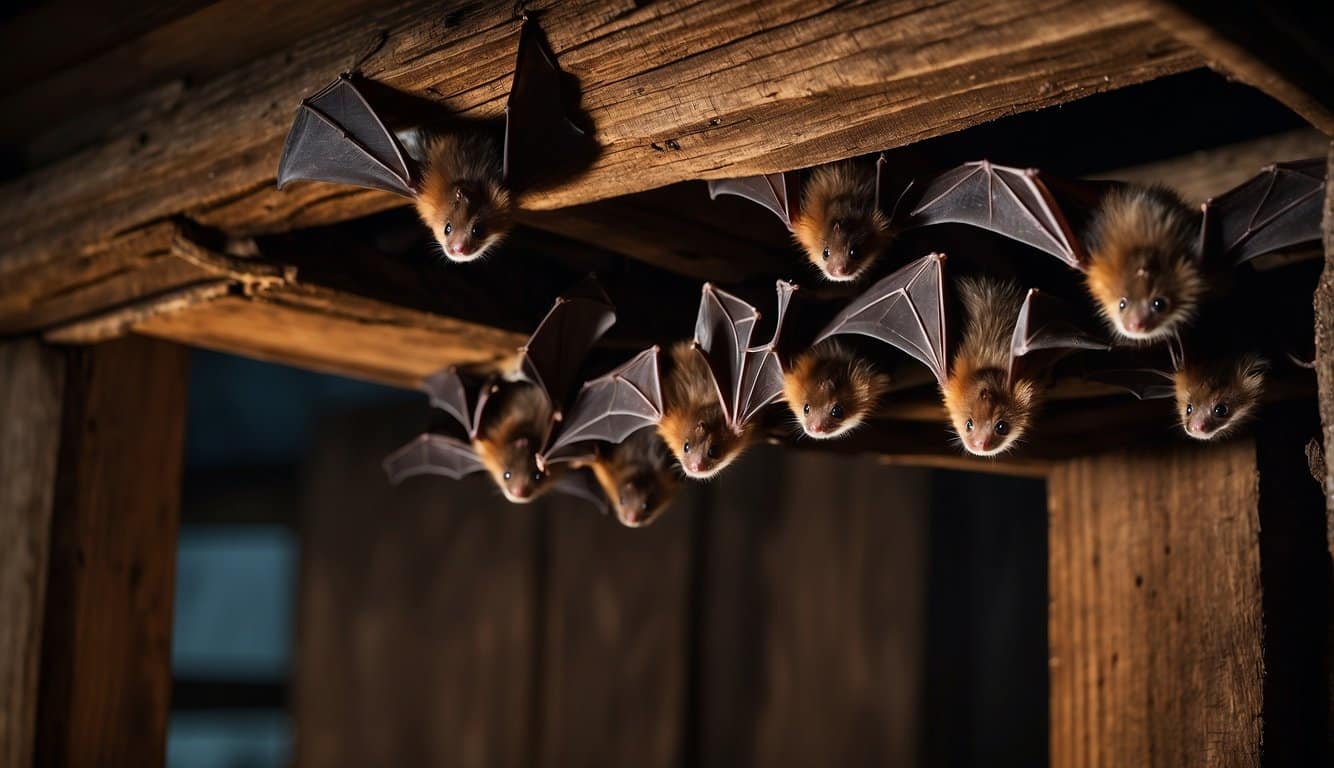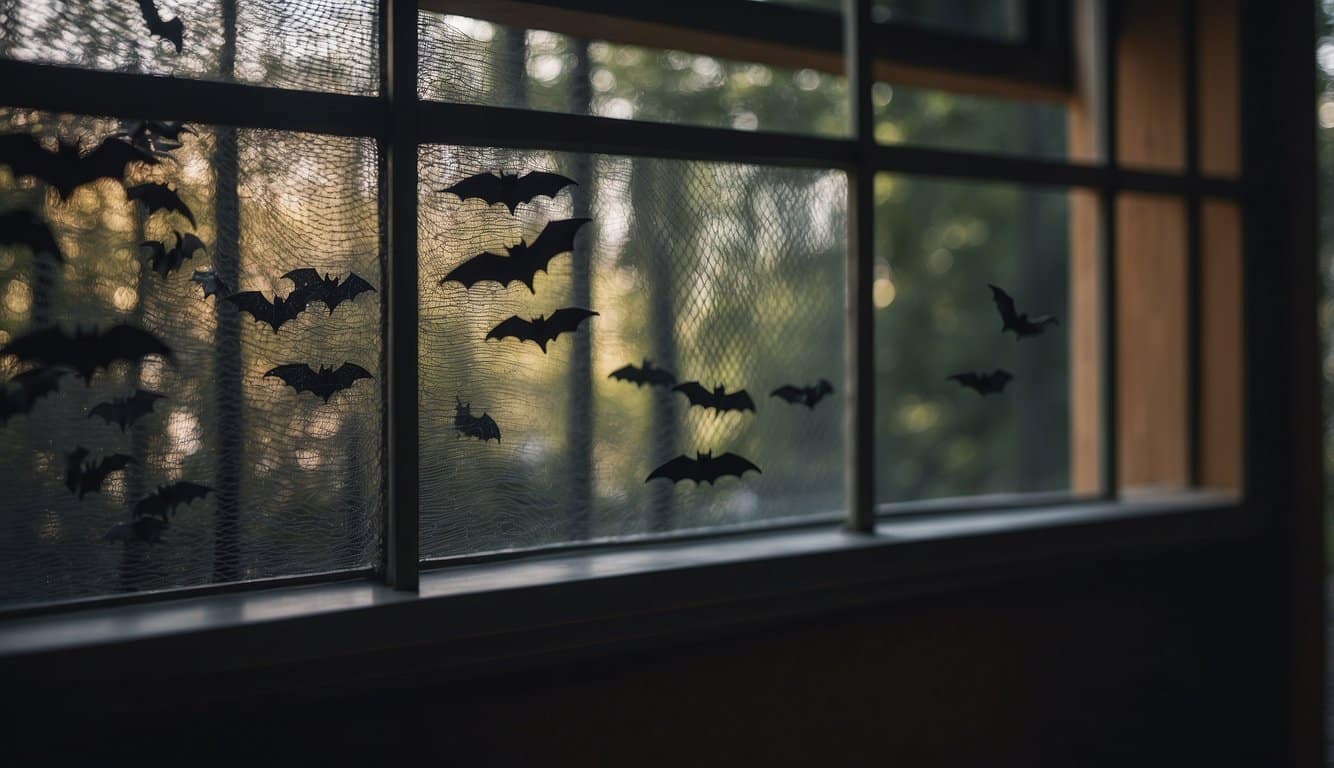Bats are known to carry rabies. We recommend calling an animal control expert for this one.
Get Rid of Bats in 8 Doable Steps
Step 1: Confirm Bat Presence
- Question: Have you seen bats entering or exiting a specific area of your building or found bat guano (droppings)?
- Yes: Proceed to Step 2.
- No: Continue to monitor, as bats are nocturnal and might be less noticeable.
Step 2: Determine the Species
- Action: Try to identify the bat species, if possible.
- Importance: Some species are endangered or have specific legal protections that dictate removal methods. Consulting a professional or a wildlife agency can provide guidance.
Step 3: Check Local Regulations
- Action: Contact local wildlife authorities.
- Purpose: Ensure compliance with laws regarding bat removal. In many places, it is illegal to harm or kill bats.
Step 4: Exclude Bats Properly
- Action: Plan for humane exclusion.
- Exclusion Devices: Install one-way exclusion devices at entry points, which allow bats to leave but not re-enter.
- Timing: Perform exclusions when it is not the breeding season to avoid trapping flightless young inside.
Step 5: Seal Entry Points
- Action: Identify and seal potential entry points.
- Materials: Use netting, mesh, or other materials that prevent bats from re-entering. Areas to focus on include vents, eaves, and gaps under roofing.
- Timing: Seal these areas after ensuring all bats have left and are not inside.
Step 6: Clean-Up Guano
- Action: Safely clean bat guano.
- Health Precautions: Wear protective gear, such as gloves, masks, and goggles. Bat droppings can harbor harmful fungi (like those causing histoplasmosis).
- Cleaning Process: Use a HEPA vacuum or dampen guano before sweeping to prevent dust. Consider hiring professionals for extensive cleanup.
Step 7: Monitor After Exclusion
- Action: Regularly check for signs of bat re-entry or new roosts.
- Ongoing Inspection: Keep an eye on previously used entry points and potential new ones.
Step 8: Consult Professionals
- Question: Are bats persisting despite exclusion attempts?
- Yes: Consult with a bat removal expert or a wildlife control professional who specializes in bats.
- No: Continue monitoring and maintaining exclusion measures.
Additional Tips
- Lighting: Bats prefer dark areas, so increasing lighting around entry points can discourage them from returning.
- Timed Exclusion: Exclusion efforts are most effective in late summer or early autumn after the young are able to fly but before hibernation begins.
Identifying Bat Habitats
When you’re dealing with bats, knowing where they hang out is half the battle. Bats prefer locations that are up high and cozy.
So, let’s break down where you might find these winged tenants setting up camp:
- Attics and Eaves: These spots offer the seclusion and shelter from the elements bats crave.
Look for signs of guano (bat droppings) or listen for the tell-tale squeaking and rustling at dusk or dawn.
- Barns and Sheds: If you’ve got a barn or shed, look up at the rafters. Bats see these structures as five-star resorts — prime real estate for raising their young.
- Trees: Specifically, check for:
- Holes in trunks
- Loose bark
- Cavities offering shelter
Bats adore natural woodland areas, so keep an eye on your gnarly old trees.
- Caves and Rock Crevises: If you’re near natural rocky landscapes, these spots are historical favourites for bats — natural insulation and protection at its finest.
- Behind Shutters and Siding: A bat doesn’t need much space to squeeze in. If there’s a gap, they might just take advantage of it.
Remember:
- Bats are creatures of habit. If you spot them once in a place, chances are they’ll return.
- While inspecting, wear protective gear to prevent any undesirable bites or scratches.
- Avoid handling bats — they can carry diseases like rabies.
For the safety of both the bat and yourself, it’s recommended to involve professional bat control services when attempting to alter or investigate their habitats.
Preventing Bats from Entering
Before you find yourself an unwilling host to these nocturnal guests, it’s crucial to cut off their access to your space. Here’s how you make your home a no-fly zone for bats.
Seal Entry Points
Bats can squeeze through openings as small as 3/8 of an inch. Here’s what you should do:
-
- Inspect Your Home: Walk around your home and scrutinize the exterior for any cracks, gaps, or holes.
Pay close attention to:
-
- Eaves
- Vents
- Loose siding
- Roof edges
- Repair the Exterior:
- Caulk: Small gaps and crevices around windows or where utility wires enter.
- Mesh: Cover larger openings like chimneys and vents with heavy-duty steel mesh.
- Solid Materials: Patch more extensive damage with materials matching your home’s exterior, such as wood or metal.
Use Bat Exclusion Devices
When bats already frequent your home, it’s time to evict them ethically:
- Bat Valves:
- These devices allow bats to leave but prevent them from returning.
- Install valves at their entry points after ensuring all bats have left to feed for the night.
- Netting:
- Use netting to cover the entry points by hanging it loosely to create a sleeve the bats can drop into but not climb back up.
- Ensure the netting is at least a foot below the entry point and sides are unsecured.
Act promptly before bats begin to roost and remember to check local wildlife regulations—bats are protected under law in many areas.
Natural Bat Deterrents
To gently encourage bats to vacate your premises, consider a couple of nature-friendly methods guaranteed to maintain the peace between your home and these nocturnal neighbors.
Installing Bat Houses
- Provide an alternative home: Installing a bat house gives bats a place to roost that is not your attic. By offering a bat-friendly structure away from your home, you encourage them to relocate.
- Placement is key: Mount your bat house facing southeast to soak up the morning sun, at least 15-20 feet above the ground to protect against predators.
Using Natural Repellents
-
- Utilize scent deterrents: Bats are put off by strong scents. A natural repellent that can be used is the essence of peppermint or eucalyptus oil.
Soak cotton balls and place them in locations frequented by bats.
-
- Texture obstacles: Bats dislike landing on sticky or slick surfaces. Applying a non-toxic, sticky substance or smooth metal foils can deter bats from roosting.
Chemical Deterrents and Repellents
When you’ve got a bat problem, and you’re looking for a quick and effective solution, chemical deterrents and repellents might just be your go-to. However, remember to always check that these solutions are legal and humane in your area before you proceed.
Here’s what you need to know about chemical deterrents:
- Safety First: Always read and follow the manufacturer’s instructions to avoid any harm to yourself, your pets, or the bats.
- Mothballs: Naphthalene, found in mothballs, is sometimes used as a repellent due to its strong odor.
- Placement: Strategically place them where bats roost but be cautious as mothballs can be toxic to humans and pets if not used properly.
- Effectiveness: May provide a temporary solution but is less effective for large colonies or long-term usage.
- Essential Oils: Some suggest that essential oils like peppermint or eucalyptus can work as natural bat deterrents.
- Application: Sprinkle a few drops of oil around the areas where bats are known to hang out.
- Commercial Repellents: Various repellents are specifically designed to repel bats with a combination of unpleasant smells and tastes.
- Considerations: Choose repellents that are environmentally friendly and non-lethal to bats.
- Results: Can vary, so it’s a good idea to try a few different types until you find one that works for your particular situation.
Professional Bat Removal
When bats decide to set up shop in your attic or eaves, it’s not just an inconvenience—it’s a call for professional help. Here’s why you’ll want to reach out to the pros to claim back your space:
- Safety First: Bats can carry diseases like rabies, and their droppings, known as guano, can harbor a lung-infecting fungus.
- Pros have the proper equipment and training to remove bats safely.
- Efficiency: Professionals understand bat behavior and can often quickly locate entry points.
- Contact humane bat control for a free inspection and tailored removal solutions.
- Legal Considerations: Bats are protected by law in many areas, making it illegal to harm or kill them.
- Professionals are savvy with these laws, ensuring a legal removal.
- Future Proofing: Once the bats are evicted, pros can bat-proof your dwelling to prevent future invasions.
- For example, they might install a bat valve that allows bats to leave but not return.
Frequently Asked Questions
Bats in your home can pose a health risk and cause significant damage. Here’s your go-to guide for bat eviction methods that are both safe and effective.
What effective methods are there for removing bats from an attic?
- Professional exclusion: The safest way to remove bats from your attic is by hiring a professional who will install exclusion devices, allowing bats to leave without re-entry.
- Sealing entry points: Once bats exit, ensure you seal all entry points, barring future access.
Can natural deterrents effectively repel bats from my property?
- Natural repellents: Utilizing deterrents such as essential oils (eucalyptus or peppermint oil), can make your property less attractive to bats. However, be prepared for a variable success rate.
What are the best practices for evicting bats from a barn?
- Alter the environment: Bats seek out quiet, dark areas.
- Introduce light and noise, or disrupt the temperature by using heaters to encourage bats to vacate.
What do professionals use to safely remove bats from buildings?
- Exclusion and professional-grade devices: Professionals often use netting and cones designed for one-way passage to safely evict bats from buildings.
How can you discourage bats from roosting around your porch?
- Bright lights and fans: Install bright lights or fans around your porch. Bats prefer calm, dark spaces so adding these elements can help deter them from settling.
Which home remedies are most effective for making bats vacate an area?
- DIY repellents: Sprinkle cinnamon, spread mothballs, or deploy ultrasonic sound emitters.
- Home remedies are hit-or-miss but can work especially in conjunction with other methods.
Last update on 2024-05-18 / Affiliate links / Images from Amazon Product Advertising API





